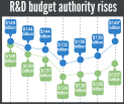News Release 17-001
Federal budget authority for research and development continues upward trend
Adjusted for inflation, R&D budget authority remains below FY 2010 levels

Health, space flight and basic research were among the largest non-defense categories of the total.
January 5, 2017
This material is available primarily for archival purposes. Telephone numbers or other contact information may be out of date; please see current contact information at media contacts.
Federal budget authority for research and development (R&D) rose in Fiscal Year (FY) 2016, the third straight year of current dollar increases, according to a new report from the National Center for Science and Engineering Statistics (NCSES).
The FY 2016 budget authority total for R&D and R&D plant (facilities and fixed equipment) came to $149 billion in current dollars, up $10.5 billion from the previous year. Federal budget authority is the primary source of legal authority for federal agencies to enter into spending commitments.
The three-year increase follows a period of notable decline for R&D, facilities and equipment budget authority. From FY 2010 to FY 2013, it steadily declined, falling a cumulative 11 percent. But in FY 2014, that trend began to reverse when the budget authority rose by $3.7 billion, followed by another $2.4 billion the following year.
In current dollars, the three years of increases roughly offset the years of decline, bringing R&D and R&D plant budget authority back to the FY 2010 level. Adjusted for inflation, however, the FY 2016 total remains below the FY 2010 level by about 10 percent.
The down-and-up shifts in funding levels were largely due to a challenging policy environment in which the administration and Congress sought to agree upon spending levels and priorities for the entire federal government, according to the NCSES report.
Spending caps and cuts in the 2011 Budget Control Act contributed to the decline in budget authority for R&D and R&D plant. Later, the 2013 Bipartisan Budget Act tempered some of those spending limits, allowing for increases. The 2015 Bipartisan Budget Act and the 2016 Consolidated Appropriations Act set federal spending levels that allowed for the $10.5 billion increase in FY 2016.
National defense accounted for 52 percent of the FY 2016 R&D and R&D plant total. Most national defense-related dollars went to programs for military R&D, testing and evaluation at the Department of Defense. Large non-defense categories included:
- Health, at 22 percent. The National Institutes of Health is the predominant recipient in this category.
- Space flight, research and supporting activities, at 9 percent. NASA is the predominant recipient in this category.
- General science and basic research, at 8 percent. This category includes mainly the R&D programs of the National Science Foundation (NSF) and the Department of Energy's Office of Science.
For more information, read the full report.
-NSF-
-
Adjusted for inflation, budget authority remains below FY 2010 levels (click for more detail).
Credit and Larger Version
Media Contacts
Robert J. Margetta, NSF, (703) 292-2663, email: rmargett@nsf.gov
Program Contacts
Mark Boroush, NSF, (703) 292-8726, email: mboroush@nsf.gov
The U.S. National Science Foundation propels the nation forward by advancing fundamental research in all fields of science and engineering. NSF supports research and people by providing facilities, instruments and funding to support their ingenuity and sustain the U.S. as a global leader in research and innovation. With a fiscal year 2023 budget of $9.5 billion, NSF funds reach all 50 states through grants to nearly 2,000 colleges, universities and institutions. Each year, NSF receives more than 40,000 competitive proposals and makes about 11,000 new awards. Those awards include support for cooperative research with industry, Arctic and Antarctic research and operations, and U.S. participation in international scientific efforts.
Connect with us online
NSF website: nsf.gov
NSF News: nsf.gov/news
For News Media: nsf.gov/news/newsroom
Statistics: nsf.gov/statistics/
Awards database: nsf.gov/awardsearch/
Follow us on social
Twitter: twitter.com/NSF
Facebook: facebook.com/US.NSF
Instagram: instagram.com/nsfgov



